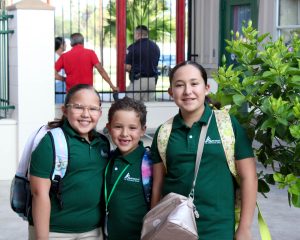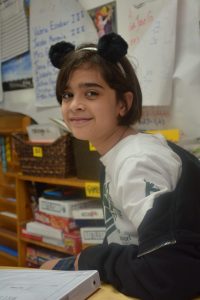Middle Elementary
3rd & 4th Grades
Our middle elementary program is designed to meet the needs of each individual child. As the child passes from the primary classroom to the elementary classroom, they become more social beings. The Montessori classroom enables these new stages of development in the child to flourish.
 The elementary classrooms are multi-age classrooms. This type of grouping creates a highly enriched learning environment. Younger children are constantly stimulated by the interesting work that the older ones are engaged in. Older students, in turn, serve as tutors and role models for the younger ones, which helps them in their own mastery (we learn things best of all when we teach them to someone else). Another benefit to a multi-age classroom is the uninterrupted student-guide relationship.
The elementary classrooms are multi-age classrooms. This type of grouping creates a highly enriched learning environment. Younger children are constantly stimulated by the interesting work that the older ones are engaged in. Older students, in turn, serve as tutors and role models for the younger ones, which helps them in their own mastery (we learn things best of all when we teach them to someone else). Another benefit to a multi-age classroom is the uninterrupted student-guide relationship.
The Montessori child is given more responsibility for their learning. They learn to manage their time, meet deadlines and work in a free non-threatening environment. The guide is there to assist and provide the experiences needed to enhance the child’s learning. Students are provided with clear expectations of their academic goals in the form of a contract. The contract directs all assignments and work choices for each child and the teacher guides them through new concepts and reviews past ones.
Our academic curriculum areas of practical life, language, math, cultural and geography are taught and reinforced through three major components; presentation of concepts, review of basic skills, and research.
The first component, presentation of concepts, is done through a spiraling curriculum. The Montessori curriculum includes; practical life, math, language (grammar, reading, spelling, writing), cultural, and geography.
The second component is the daily review of basic skills. Students are expected to complete a weekly contract set up by the guide and the student. The contract includes basic skills and review of concepts presented.
The last component is research. Students practice being responsible and resourceful scholars by actively researching topics assigned or of interest to them.
Practical Life
Practical life activities are the activities of everyday life. The child practices these activities in the classroom to gain knowledge of how to accomplish life skills in a purposeful way. This takes the form of classroom jobs such as organizing the library, sweeping the classroom, reporting the weather, charging the iPads, taking out the trash, etc. These jobs allow students to have a sense of responsibility through their day-to-day tasks.
Math
The math curriculum is sequenced with most concrete material working their way up to abstraction. The math curriculum includes number theory, algebraic thinking, geometrical figures and objects, measurement, data analysis, and probability.
Language
 The language curriculum includes grammar, reading, writing, spelling, and speaking skills. The students are introduced to the parts of speech, grammatical writing, word study, and figurative language. Their grammar presentations are then transferred to their writing. In writing the students use the 6 Traits of Writing which include idea, organization, word choice, sentence fluency, voice, and convention. Students also receive direct instruction using “Empowering Writers” in expository, letter, narrative, persuasive, and poetry writing. Scientific spelling is part of our spelling curriculum. This teaches students how to spell words by using reliable patterns and rules of the English language. The reading curriculum includes practicing reading skills through novels, passages, SRA, and are monitored using the Accelerated Reading program. This allows students to practice their comprehension and develop specific reading skills. Students are also able to practice public speaking through read-a-louds, plays, and presentations in the class.
The language curriculum includes grammar, reading, writing, spelling, and speaking skills. The students are introduced to the parts of speech, grammatical writing, word study, and figurative language. Their grammar presentations are then transferred to their writing. In writing the students use the 6 Traits of Writing which include idea, organization, word choice, sentence fluency, voice, and convention. Students also receive direct instruction using “Empowering Writers” in expository, letter, narrative, persuasive, and poetry writing. Scientific spelling is part of our spelling curriculum. This teaches students how to spell words by using reliable patterns and rules of the English language. The reading curriculum includes practicing reading skills through novels, passages, SRA, and are monitored using the Accelerated Reading program. This allows students to practice their comprehension and develop specific reading skills. Students are also able to practice public speaking through read-a-louds, plays, and presentations in the class.
Cultural
Dr. Montessori recognized that elementary children have a special sensitivity for the acquisition of culture. One way is through the introduction of timelines. This provides children with an overview of key principles to discover events and people in our world.
Cultural is broken down into three sections, history, science and geography. History allows students to explore communities, discuss the development of transportation, education, health services, and laws. Students also understand what communities need to thrive, such as the concept of the free market and the use of tax money. Students will also dive into Texas history. Researching Texas from colonial times to settlements, gaining its independence from Mexico and joining the United States. Students read and learn about historical figures in Texas history along with Texas historical markers.
In Science students explore life, earth, and physical science through hands on experiments and discussions in class. Students research and discover new concepts through FOSS and Science SRA activities.
Through the geography curriculum students explore our world countries. Students master the atlas and locate countries, capitals, and the respective flags of the countries. Students also practice their map skills through explicit instruction on reading maps, learning the parts of a map, studying different types of maps, and creating maps.
